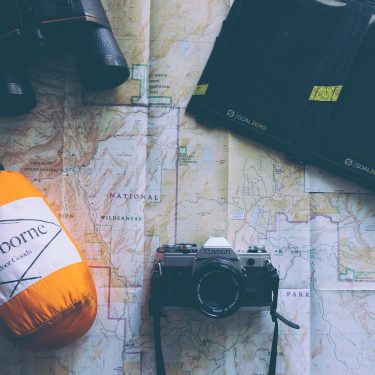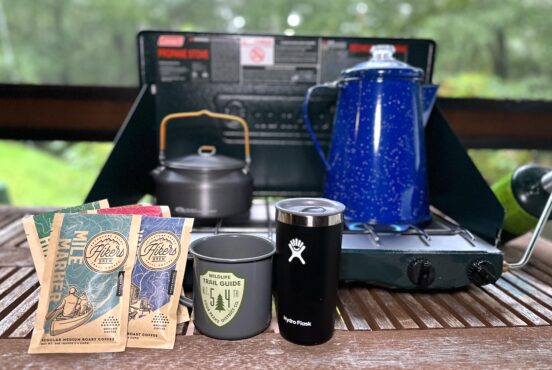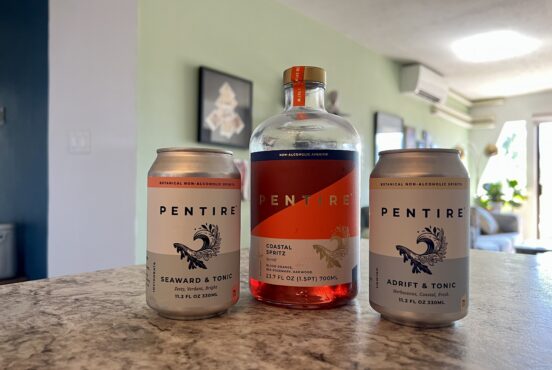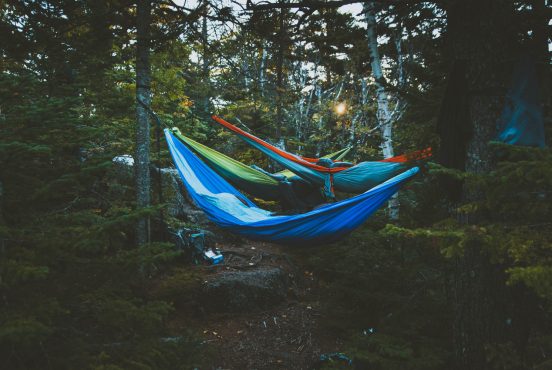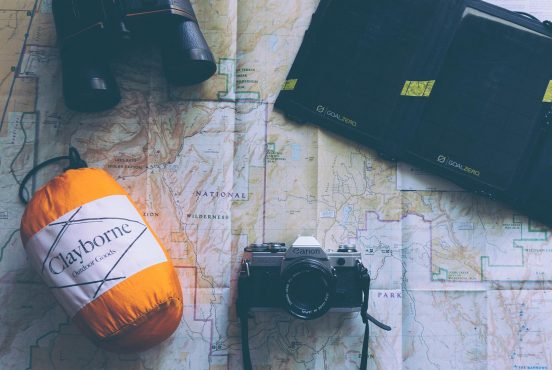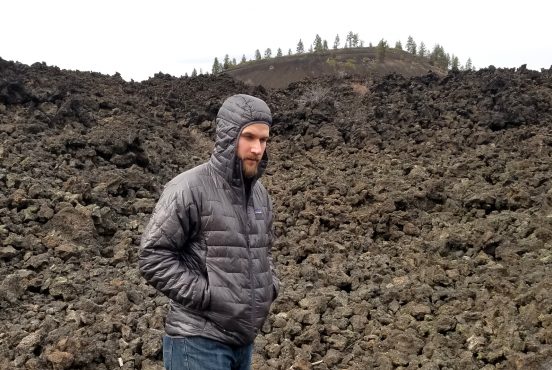We research, test and evaluate outdoor gear based on a number of factors, including our writers’ experience and expertise, trusted user reviews and more. We may earn a commission when you make a purchase through our links. See our editorial policy to learn more.
The best tent heaters offer efficient warmth with safety in mind. Here’s how to choose the right heater for your next campout.
Camping in my younger days meant a backpack full of old used gear and a whole lot of wingin’ it. Spontaneity was the name of the game, and my brothers and I survived some epic camping trips that way.
But three kids and a decade later, camping now is about preparation and finding slices of comfort where we can. One of those newfound comforts is a tent heater, something we started using a few years back that made a huge difference in the quality of our nights outside.
No matter your camping style, a tent heater can extend your season far into fall and winter, making it a solid gear addition for even the most hardy campers.
Here’s a look at five of the best tent heaters for cold weather, and how to find the right heater for your next camping trip.
Our Top Picks
- Best overall: Mr. Heater Portable Buddy Heater
- Best for small tents: Mr. Heater Little Buddy Heater
- Best for large tents: Mr. Heater Big Buddy Heater
- Best mid-sized heater: Mr. Heater Hunting Buddy Heater
- Best kerosene heater: Dura Heat Indoor Kerosene Heater
Best Overall: Mr. Heater Portable Buddy Heater
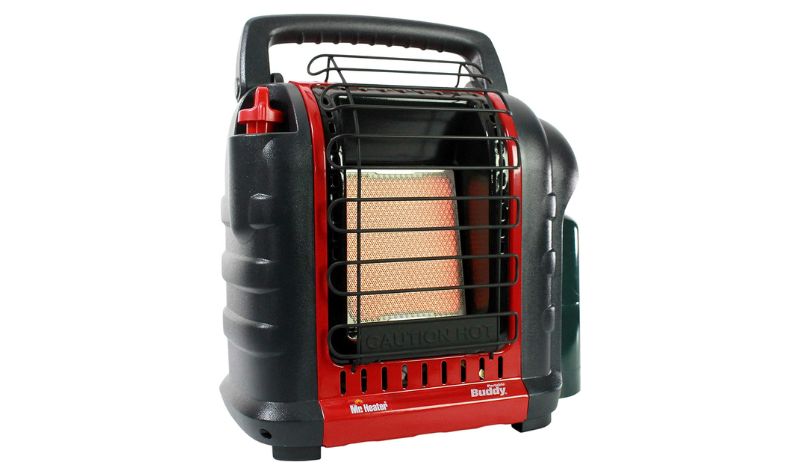
Why it’s a good buy: The top-selling tent heater in America, and it’s not particularly close.
- BTU range: 4,000 to 9,000
- Coverage: 225 square feet
- Run time: 2.4 to 5.4 hours
- Fuel type: Propane
Back in the day, a few big outdoor brands like Coleman made tent heaters, but they never performed all that well and were soon retired to the gear graveyard. But in 2000, Mr. Heater’s Buddy Series changed the game.
Their Portable Buddy finally made a propane-based tent heater that was consistently safe and effective. With a low-oxygen sensor that automatically shut off propane, the heater was safe for tents and the campers inside – no more worrying about the tent filling with dangerous carbon monoxide.
There’s also a tip-over safety feature that automatically shuts off the heater if it tilts. This shouldn’t happen of course, and the grip on the bottom of the heater is meant to keep it in place. But with kids, dogs, spouses – anything can and will happen in a tent, so it’s nice to know your heater malfunctioning isn’t something to worry about.
Like all of the Mr. Heater Buddy heaters, the Portable Buddy hooks up to a standard one-pound propane tank. If you’re using propane for your camp stove or other appliances, it’s even easier to make sure you’re fueled up for your next trip.
Starting the tent heater is simple, and it works well up to 7,000 feet in elevation. It can work above that level, but the heater’s likely to go out because of lower oxygen levels, making it less reliable.
It’s meant to heat spaces up to 225 square feet, but you’ll notice that the actual warmth in your space depends on where it’s located and the overall temperature. This tent heater would work well for any family-sized tent designed for groups of 6 or more.
The Portable Buddy has more than 4,500 reviews on Amazon, the majority of which (91%) have 4 stars or above. There’s a reason this is the most popular tent heater in the country, and Mr. Heater continues to make changes to this model to make it safer and more effective than ever.
Shop at AmazonBest for Small Tents: Mr. Heater Little Buddy Heater
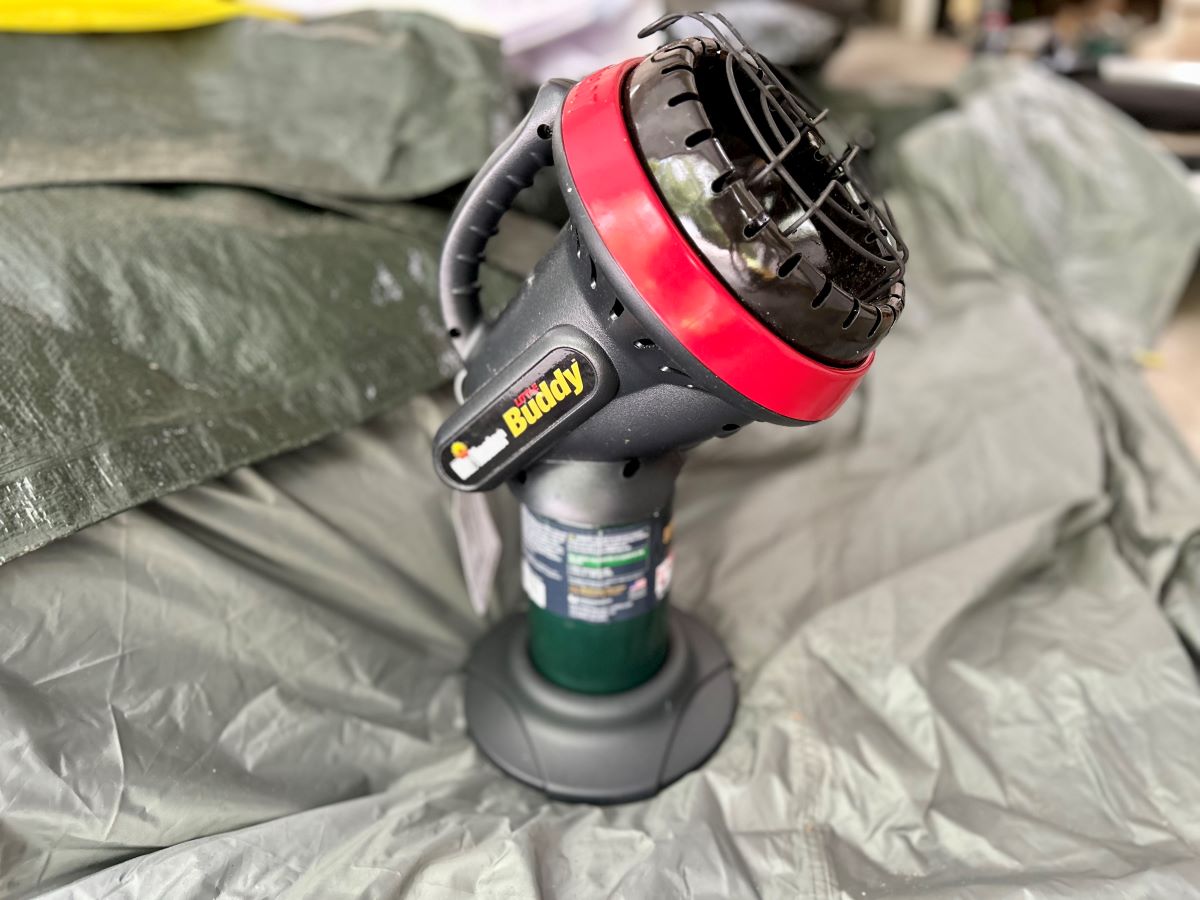
Why it’s a good buy: A small but strong tent heater with an efficient footprint and under-the-radar heat performance.
- BTU range: 3,800
- Coverage: 95 square feet
- Run time: 5.6 hours
- Fuel type: Propane
Our family tent is a two-room shelter that’s great for separating the kids and adults, and to keep the kids’ side warm, we purchased the Little Buddy several years ago.
Just like the Portable Buddy, this tent heater works wonders, and because of its more compact size, it doesn’t add much bulk to your camping gear. It’s easy to set up, and though it’s small, you can feel the radiant heat from across a tent room (or small tent).
Pro life tip: Don’t wait ’til late at night in the dark to screw your propane tank in for the first time. Practice at home so you can switch tanks in and out at 3am like a champ.
Our experience with this tent heater has always been positive: the safety features work well, it’s never leaked and puts off a surprising amount of heat for its size. If you just need enough heat to get comfortable, but not toasty, this is a great option.
The run time is also solid, though like most of the Buddy Series heaters, you’ll likely need to replace the propane tank in the night if you want to go from bedtime to morning with it on. And as long as your tent has a little ventilation for air circulation, that’s totally doable.
Shop at AmazonBest for Large Tents: Mr. Heater Big Buddy Heater
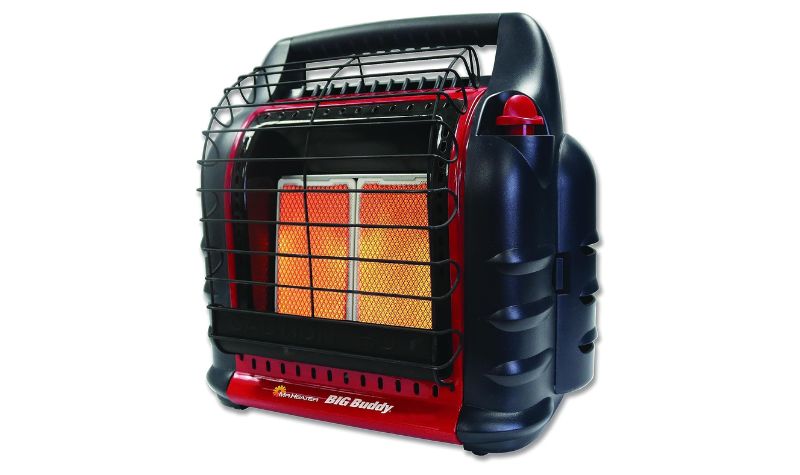
Why it’s a good buy: A powerful yet safe tent heater that’s big enough to heat up just about any size shelter.
- BTU range: 4,000 to 18,000
- Coverage: 450 square feet
- Run time: 2.4 to 10.8 hours
- Fuel type: Propane
This heater is just as the name implies: big. It maxes out at 18,000 BTUs, or double the Portable Buddy’s heating ability. And not surprisingly, it heats up twice the amount of space.
The Big Buddy’s main benefit is that it runs on two one-pound propane tanks instead of one. That gives it a longer running time on its lowest setting, but it also means you won’t have to switch tanks out as often as you would with smaller heaters.
Still, running on the highest setting, the Big Buddy will only last about 2.5 hours, something to keep in mind if you’re stocking up on propane for a weekend in extreme cold.
Like the Portable Buddy and Hunting Buddy below, you can buy additional attachments to connect the Big Buddy to a 20-pound tank and use it as an outdoors heater as well.
Shop at AmazonBest Mid-sized Heater: Mr. Heater Hunting Buddy Heater
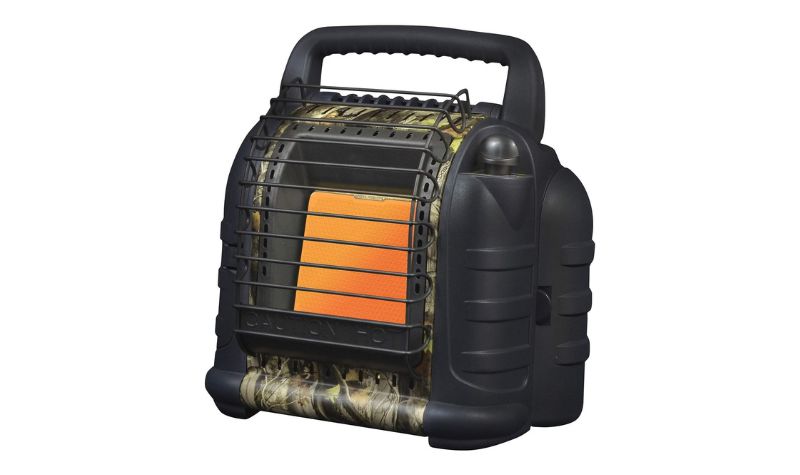
Why it’s a good buy: A well-reviewed mid-sized tent heater that works well for outdoor hobbies.
- BTU range: 6,000 to 12,000
- Coverage: 300 square feet
- Run time: 1.8 to 3.6 hours
- Fuel type: Propane
The Hunting Buddy fills a mid-sized need between the Portable Buddy and Big Buddy. It’s powerful enough to deliver sufficient heat, but it’s not so large that you can’t haul it to a hunting blind or frozen lake.
Because of its positioning in the Buddy Series, the Hunting Buddy doesn’t always get the recognition of the more popular models, but it performs just as well and offers the same safety and convenience features. It’s also the only Buddy model that uses an electric instead of Piezo-type ignition.
Aesthetically, the Hunting Buddy ditches Mr. Heater’s iconic red branding for a subtle camouflage that’s properly suited for vibing in the backcountry.
Look through this tent heater’s reviews and you’ll find plenty of users that swear by the Hunting Buddy’s heating performance while hunting, fishing and camping.
Shop at AmazonBest Kerosene Heater: Dura Heat Indoor Kerosene Heater
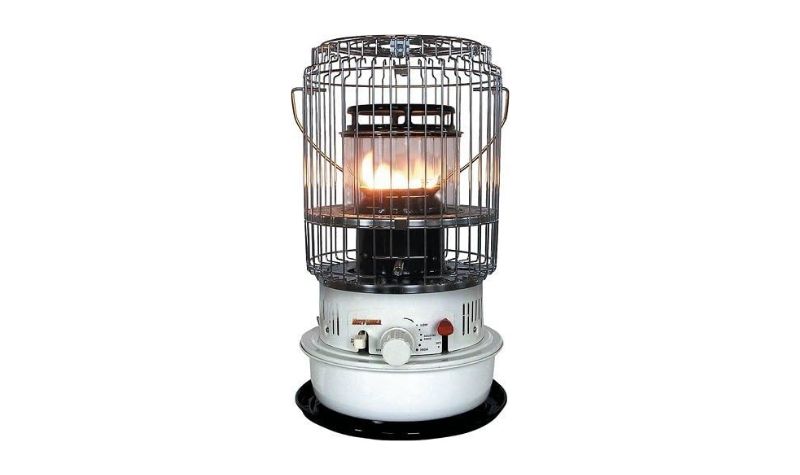
Why it’s a good buy: A kerosene tent heater strong enough to warm up tents, small homes and more.
- BTU range: up to 23,800
- Coverage: 1,000 square feet
- Run time: 8 to 12 hours
- Fuel type: Kerosene
Although propane’s a popular fuel type for tent heaters, you can also find kerosene and butane heaters that work just as well. The Dura Heat Indoor Kerosene Heater is a popular kerosene option that offers complete 360 degrees of heat, something the Buddy Series lacks.
With its 23,800 BTU maximum, this Dura Heat Model can heat a lot more than tents, and works well as an emergency heat source for cabins, small homes, shops and garages. And although it’s rated to heat up to 1,000 square feet, some reviewers have noted that it sufficiently heats up more room than that.
This model’s considered just as safe as the Buddy Series tent heaters, and has a “no-lift” feature that limits the smell and exposure to kerosene when starting the heater. As with propane heaters, you’ll want to ensure there’s enough space and ventilation in the room to avoid carbon monoxide buildup.
Depending on the price and availability of kerosene in your area, this might not be the most convenient or cheapest tent heater – it can run through tanks quickly – but it’s a solid alternative to propane nonetheless.
Shop at AmazonTent Heater Buyer’s Guide
Finding the ideal heater is about knowing the size of your tent space and the power of your heater. Here’s how to find the best tent heater for your needs, and what to consider for max comfort.
Type of heater. There are two main types of heaters you can use tent camping: electric and gas. Because electric heaters require a generator or an extension cord to your car, we’ve skipped them for the sake of focusing on gas heaters, though there are plenty of solid electric heaters on the market.
Our list includes heaters that run on propane and kerosene, though others run on fuels like butane. Gas-powered heaters require proper ventilation, but those designed for indoor spaces are considered safe for tent camping.
You can get sufficient air ventilation by simply cracking open a tent window or flap, and if you want to be extra cautious, you can bring a CO detector. The tent heaters we’ve included here are all designed with safety mechanisms to avoid carbon monoxide issues.
Heating power. Portable heaters’ heat output is measured in BTUs, or British Thermal Units. A higher BTU rating means a stronger heat output, and with tent heaters you generally won’t need more than 25,000 BTUs.
Our recommended tent heaters range from 3,800 BTUs for smaller tents to 23,800 BTUs for larger tents and small cabins and homes. With factors like outside temperatures and other considerations, it’s difficult to pinpoint exactly how many BTUs you need to comfortably heat your tent, so think of heating output in relative terms.
It’s also important to remember that bigger isn’t always better, and a larger, more powerful tent heater can burn through fuel faster than a smaller heater better suited to your tent space and temperature.
Recommended space. Most heaters are rated to heat a certain square footage. The Little Buddy, for example, is designed to heat up to 95 square feet, which is plenty for most four-person tents or smaller. Larger families tents or multi-room tents may require the Portable Buddy, designed to heat up to 225 square feet.
Recommended space isn’t the end-all, be-all factor, however. A 100-square-foot tent will warm up much faster on a 40°-night than on one that drops down to 20°, so know that space, like heating power, is a relative factor.
Real-world heating capacity also depends on other factors, like where your heater’s located and your tent’s overall ventilation. A family tent crammed with four kids and gear also heats up quicker than one with lots of bare, uncovered tent floor.
Proper use. Tent heaters of any type should be placed on smooth, flat and safe surfaces – never on anything that could fall or move during the night. They shouldn’t be used for cooking or any other unintended use, and you should only use accessories and attachments made for that heater.
Before each use, check your heater and propane or kerosene tanks for signs of defect, and if you get that unmistakable rotten egg odor from your heater, check your setup for leaks or damage.
This concludes the boring part of our guide.
Tent Heater Alternatives
Tent heaters give off the most heat, sure, but there are other low-tech ways to stay warm while camping.
First, consider hand warmers. They’re surprisingly effective, especially if you grab a bulk box and use a few each night (they also make larger body warmers with adhesives). Place one near your core and one at the bottom of your sleeping bag for best results.
I’ve had many a night in the tent where I’ve had to take out a hand warmer from my sleeping bag because it got too toasty. They’re small but mighty.
Next, consider a Zippo hand warmer that runs on fuel or lighter fluid. It’s safer than it sounds and lasts longer than your average hand warmer. Finally, if you’re going the DIY route, try filling up a water bottle with hot water from your campfire (if your bottle’s designed to handle it).
“Fill up your hard plastic bottle with hot water and go to bed with it between your legs so it hits your femoral artery,” says Shelby Carpenter at REI. “If the bottle is too hot to the touch at first, wrap one of your layers around it and then place it between your legs.”
Growing up, we did the same thing with large rocks: place one by the fire before going to bed, then wrap it in an old shirt before cuddling said rock in your sleeping bag.
Works wonders, and we only occasionally burned holes through shirts and sleeping bags. I can’t attest to the water bottle trick, but I have woken up to still-warm rocks in my crotch area. For liability reasons I cannot recommend this method.
Tent Heater FAQs
Which heaters are safe for tents?
Heaters considered safe for tents are designed for indoor use and typically have safety features like tip-over detection, which stops the heater from working when tilted. They also have low-oxygen sensors that automatically turn off a heater if the oxygen level in a room dips below a certain point.
Nearly all heaters can be used outdoors or in very large spaces, but it’s important to only consider heaters that are explicitly made for small indoor spaces when looking for one to heat your tent.
In Mr. Heater’s Buddy manuals, for example, they include language that makes it clear the products are safe for tent camping, saying the heater is “safe for indoor use in small recreational enclosures having means for providing combustion air and ventilation, such as enclosed porches, cabins, fishing huts, trailers, tent trailers, tents, truck caps and vans.”
Can you get carbon monoxide poisoning from a propane heater?
Although our recommended tent heaters are safe to use in tents, they require proper air ventilation to work and avoid carbon monoxide issues.
According to Johns Hopkins Medicine, the most common cause of carbon monoxide poisoning is using space heaters without proper ventilation. “An unvented space heater uses combustible fuel and indoor air for the heating process,” says the healthcare network. “It vents the gases it makes into the room, instead of outdoors.”
The same idea applies to tents: when you use a propane heater, it’s important to crack a tent window or flap so fresh air can enter and carbon monoxide can exit the tent. It doesn’t need to be much ventilation, and you don’t want to let in so much air that it defeats the purpose of having a heater.
So yes, it is possible to get carbon monoxide poisoning from a propane heater, which is why it’s important to only use heaters designed for indoor use, with low-oxygen sensors and tip-over safety features. When indoor tents are used properly, there is little risk of carbon monoxide poisoning.
Can you leave a propane heater on all night?
If the propane tent heater is designed to be used indoors, it can be left on all night when used properly. With the Mr. Heater series, there is a low oxygen sensor that shuts off if there’s a dangerous amount of carbon monoxide in the room.
When your heater is placed on flat, safe surfaces away from people or things, and the tent has sufficient air ventilation, you can use your tent heater all night with no issues. If you still have safety concerns, you can pick up a carbon monoxide detector to use in your tent just in case.
How long will a Buddy heater run on a one-pound tank?
Depending on the Buddy model, these heaters run between 1.8 and 10.8 hours on their propane tanks. The Big Buddy takes two tanks, which allows it to last longer. See the chart below to compare the Little Buddy, Portable Buddy, Hunting Buddy, and Big Buddy.
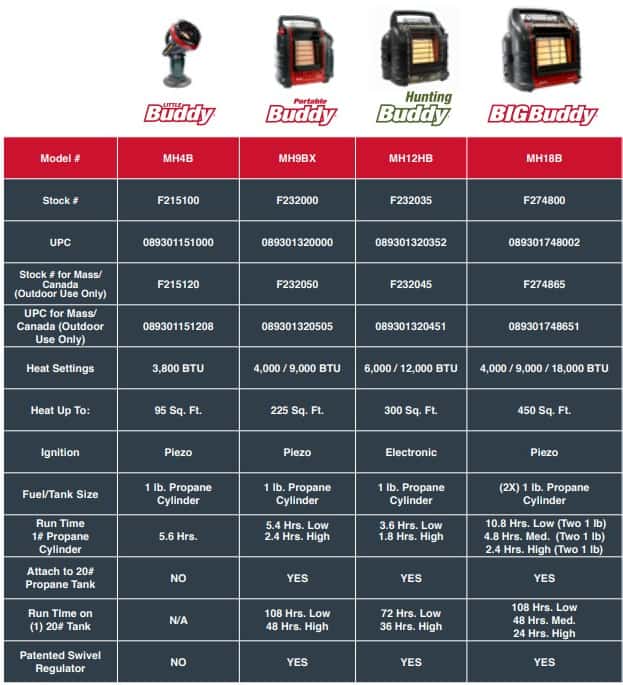
How to Stay Warm While Tent Camping
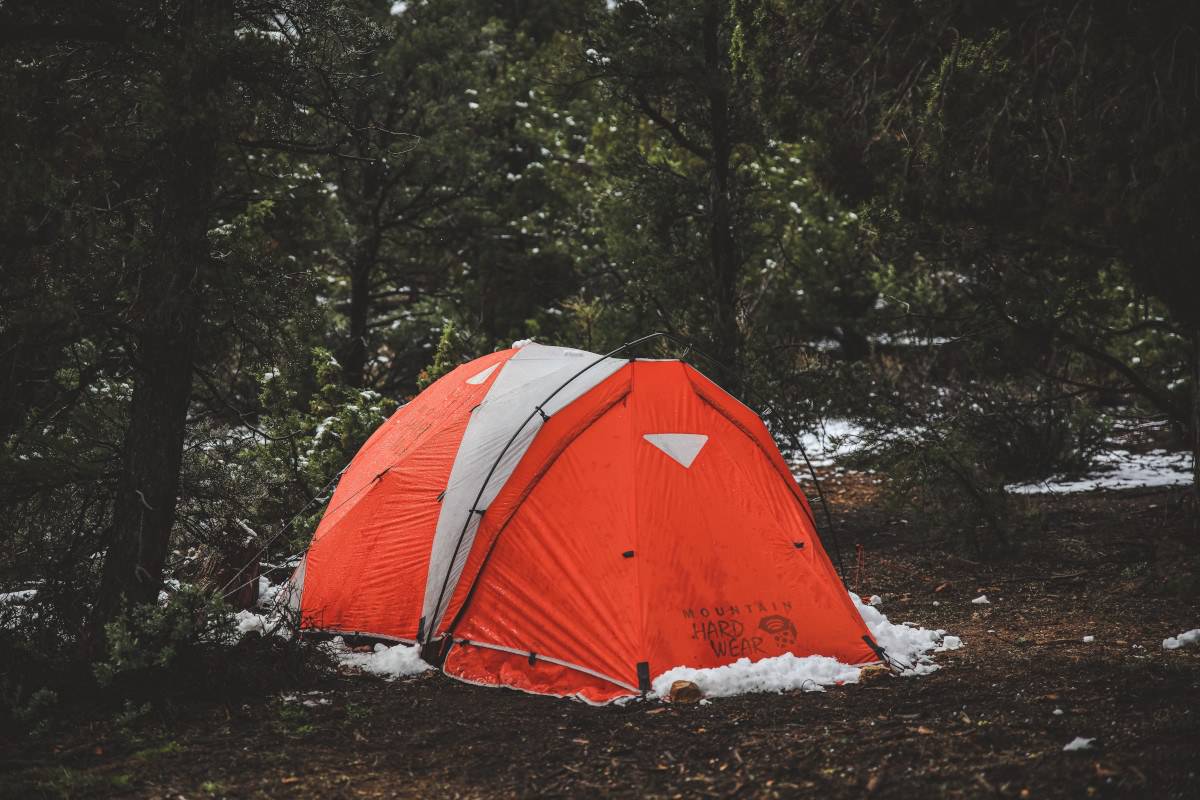
No one goes camping to be comfortable, we get it – but staying warm can make things more enjoyable, especially when you’re roughing it with kids. Here’s a rundown on the little things you can do to stay warm when it matters.
Invest in a good sleeping bag. The right sleeping bag can make all the difference on chilly fall and winter nights. Sure, some camping gear’s overpriced and unnecessary, but if you’re going to invest anywhere, do it in something that pays off in comfort and warmth.
Consider the type of camping you’ll do – how many seasons and where – and if your budget allows, buy a sleeping bag that’s warmer than you think you’ll need.
“Sleeping bags for winter camping should be rated to temperatures below what you will likely experience if you want to be comfortable,” says Outdoor Action’s guide to winter camping.
Wear fresh clothes to bed. After a busy day setting up camp, check into fresh, dry clothes before hitting the sack – even if it’s already cold out.
“While it may be hard to strip down in harsh conditions, you’ll be grateful you did,” says the team at MSR. “Throwing on dry clothing revives your warmth. Put on new socks as well. Then, layer up with as many pieces as you need to feel comfortable.”
Don’t make the mistake of overdoing it, however. Your sleeping bag’s most effective when it traps and radiates your body’s own heat, and if you’re stuck under 10 layers of bulky clothes, you’ll lose the advantage of heat that would otherwise keep you warm.
Stay off the ground. Even the best sleeping bag in the world won’t keep you warm if you don’t have a good way to get off the ground.
Car camping air mattresses aren’t always made for cold-weather trips, so opt for a sleeping pad that’s insulated and made to be a barrier between you and cold earth.
The thickness doesn’t matter as much as the material, which is why Kristin Hostetter at Backpacker Magazine recommends going with a closed-cell sleeping pad on top or below your air mattress.
Don’t breathe into your bag. When the going gets tough, it’s easy to curl into a fetal ball and zip yourself into your sleeping bag, questioning why you ever thought camping in this weather was a good idea.
But exhaling into your bag can lead to condensation over the course of the night, and it doesn’t take much to turn your bag into a moist cave of chilliness by the time dawn rolls around. If your head’s cold, throw on a beanie and brave the open air.
Gear Up for Camping
Sign up for our free email to join thousands of readers getting epic travel ideas every week.
Seen in: Camping Gear, Gear

